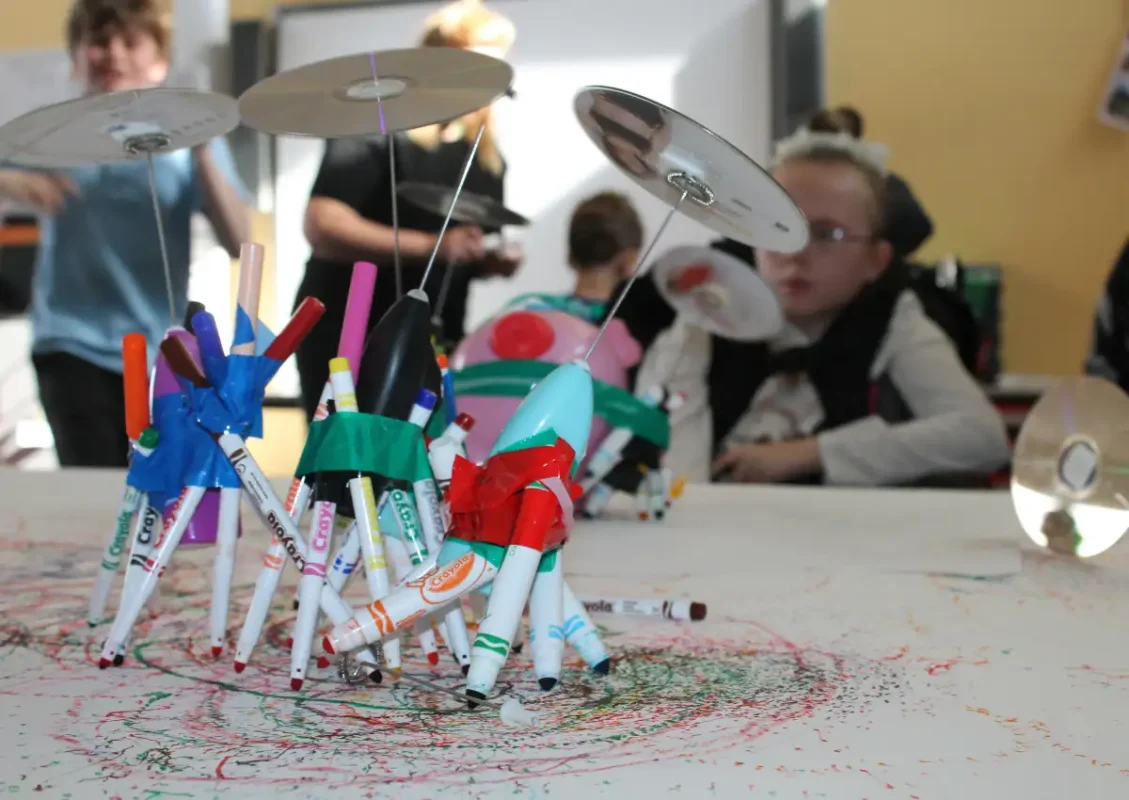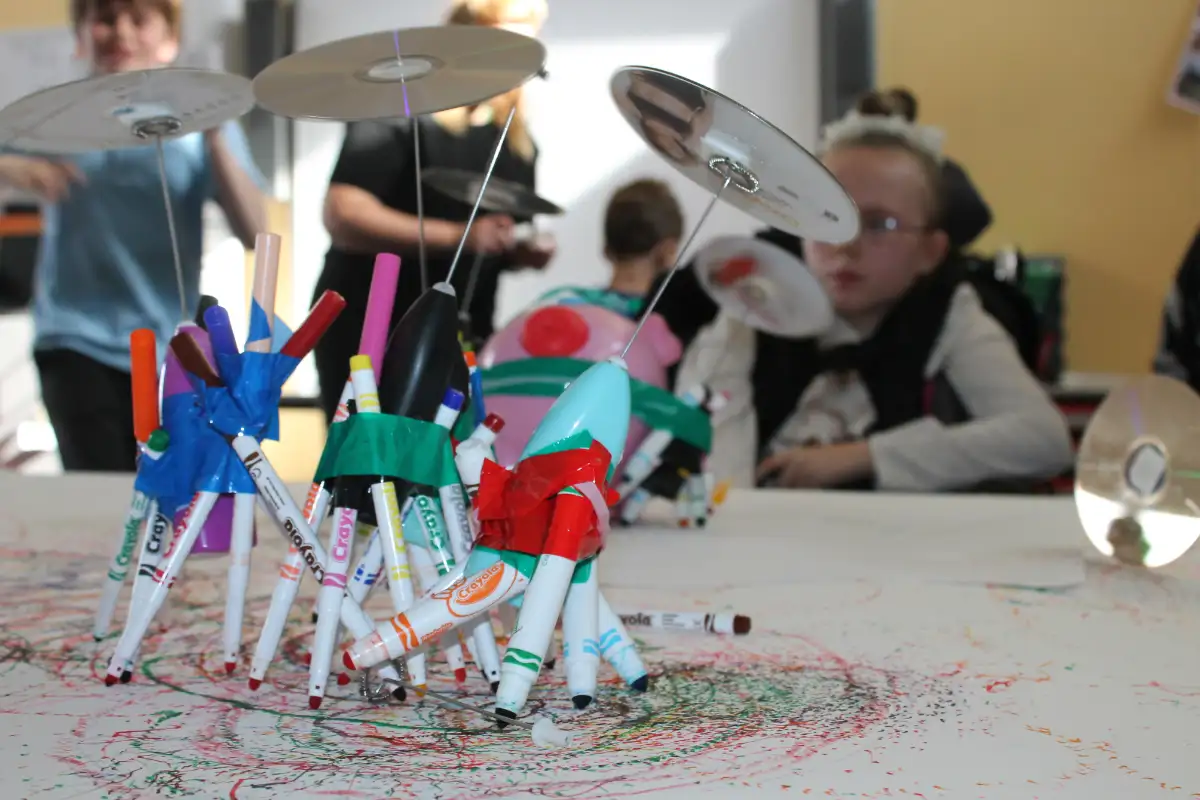How Ashmount School empowered SEND pupils through a child-led approach to the arts.

Students from Ashmount School
This case study, about a partnership between Ashmount School and Attenborough Arts Centre, describes the value of arts and creativity in empowering young people with Special Educational Needs and Disabilities (SEND). Written by The Mighty Creatives.
This is one of 25 case studies highlighting the value of arts in schools and education settings, curated by arts education researcher Sarah B Davies. The suite of case studies illustrates the research The Arts In Schools: Foundations for the Future, by Pauline Tambling and Sally Bacon, due to be published in 2023.
About the school and its project
Ashmount School is a Special Educational Needs and Disabilities (SEND) school for pupils aged 4 to 19 years. Based in Loughborough, Leicestershire, the school moved to a brand-new building in January 2014, where it offers a broad range of specialist facilities including multi-sensory and soft play spaces, a heated swimming pool, and dedicated art, music, and cookery rooms.
In 2019, the school achieved Platinum Artsmark, working with a wide range of cultural organisations and other school partners. Attenborough Arts Centre (AAC) were the school’s key partner, working together on the AAC’s SENsory Atelier Project, funded by Paul Hamlyn Foundation. Together, they explored new ways to learn, discover, and cultivate imagination. The project centred on children, teachers, and artists co-researching to create their own teaching and learning practices, exploring the Reggio Amelia Approach (an educational philosophy) as a provocation for empowering creativity and agency for students with complex needs.
Activities included:
- Using Artists in residence to provide exciting, inspiring, and engaging programme of opportunities.
- Co-producing projects with the students using the Reggio Emilia Approach, following the students’ lead and interests.
- Visiting the AAC gallery once a term so pupils could interact with high-quality exhibitions.
- Developing a close partnership with other SEN schools, and their leadership teams, by participating in regular steering group meetings.
- Supporting children to curate exhibitions of their work and share their successes at regular celebration events.
- Placing pupils at the centre of their learning and empowering them to become co-designers of the curriculum.
- Joint Professional Development (JPD) for staff.
What worked well
“Our Artsmark journey centres on ensuring positive and inclusive experiences. From their entry into school, pupils have continuous access to wide-ranging, challenging arts and cultural experiences which are fully differentiated to maximise accessibility.”
Ashmount described the learning and impact of their Artsmark journey and the project as, “far greater than anticipated”. Prior to 2017, the school’s access to arts and culture was almost exclusively within school. Since then, 92% of pupils have accessed major exhibitions in galleries, and the school has developed a range of resources to enable pupils to examine professional artists’ work so that they can better understand their own creativity.
Pupils now have agency in determining what is taught, how they learn, and how their experiences are recorded. Since including pupil panels in the school’s curriculum-planning process, students have become co-producers designing format and progression of sessions.
Ashmount has seen a significant ethos shift across the school by embracing the value of a child-led approach. Pupils are now co-producers, rather than viewed simply as consumers of learning. The ethos of co-production is at the heart of an inclusive approach. The young people’s views, feelings, and ideas direct the development of the arts and cultural curriculum within school.
In 2019, Ashmount began a pioneering MaxLiteracy project. This involved the development of resources to aid non-verbal children with very limited movement, empowering them to make creative responses to cultural stimuli. This work, undertaken with AAC and poet, John Berkivitch, has “stretched the current understanding of what is possible creatively for pupils typically ‘without a voice’.” Eye-gaze software and touch-based equivalents have been created, in conjunction with Smartbox, and are the first of their kind. The project has enabled pupils with profound learning difficulties to experience new language and produce visual poetry. These materials have the potential to revolutionise access to art and culture for non-traditional communicators.
What was the impact?
- 63% of pupils, 50% of teachers and 64% of curriculum support assistants (CSAs) have been directly upskilled as part of their Joint Practice Development (JPD) model, working alongside professional artists.
- The school identified a 136% increase in pupils’ completion of Arts Awards above Discover level, and a 35% rise in those learning tuned instruments.
- Ashmount has shared and led training opportunities within, and beyond, the school. They became an Ambassador School in the four-year Paul Hamlyn Funded SENsory Atelier programme, supporting sharing of best practice across nine partner schools.
Staff also reported significant gains against milestones in pupil engagement, confidence, and expressive language. The school has extended external accreditation of cultural experiences via ASDAN and 73% of teachers are Arts Award trained. All pupils work alongside professional artists, while opportunities to undertake placements in cultural venues are now embedded in long-term plans for careers development.
Parents’ expectations have raised exponentially, as they’ve come to recognise their child’s creative potential and celebrate their accreditation. One said, “I never thought my child could have achieved an Arts Award”. The school has seen an increase in uptake of opportunities to access cultural venues, and more families are recognising employment within the arts as a genuine and viable option for their child.
View this video to hear first-hand from Ashmount School
What can others learn?
“My experiences at Ashmount have transformed the way I approach creating work…and the way I will make performativity work in the future.” - John Berkavitch, Poet
Ashmount’s Senior Leadership advocates strongly for the centrality of arts and culture in education. Following the school’s involvement in the DfE’s pilot study into assessment of pre-formal learners, the assessment is now based on “seven aspects of engagement”. The school’s leadership team has developed the use of this tool to record engagement with, and responses to, arts and culture.
Working with The Mighty Creatives (TMC) – the East Midlands Bridge organisation funded by Arts Council England – the school delivered a keynote speech to other schools; this provided an opportunity to share their dynamic and creative approach to building and protecting provision, and how to develop new ways of measuring learning and engagement for pupils with SEND. Ashmount has proved successful in demonstrating how national agendas can be effectively and powerfully applied in an arts context.
Feedback to Ashmount has revealed that the school has become an impactful opinion-former, raising standards and stretching the skills, knowledge, and understanding of those working in similar contexts nationally. The school was particularly proud to enable four pupils to present at the SENsory Atelier Symposium. This opportunity challenged both the students and the assembled audience, as pupils spoke with great passion about their own varied experience.




